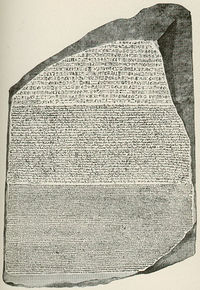Written Languages
Dan Tobias (Talk | contribs) (→Alphabetic systems) |
m (→References) |
||
| Line 49: | Line 49: | ||
* [http://www.mentalfloss.com/blogs/archives/148212 7 Ancient Writing Systems That Haven’t Been Deciphered Yet] (Mental Floss) | * [http://www.mentalfloss.com/blogs/archives/148212 7 Ancient Writing Systems That Haven’t Been Deciphered Yet] (Mental Floss) | ||
* [http://www.bbc.co.uk/news/business-19964786 Breakthrough in world's oldest undeciphered writing] (BBC) | * [http://www.bbc.co.uk/news/business-19964786 Breakthrough in world's oldest undeciphered writing] (BBC) | ||
| + | * [http://www.bbc.co.uk/news/science-environment-21427896 Ancient languages reconstructed by computer program] (BBC, 2013-02-12). This deals with spoken, rather than written languages, but it's still of interest. | ||
Revision as of 12:58, 12 February 2013
Writing dates back to approximately the 4th millennium BC, and marks the boundary between "prehistoric" and "historic" times.
Written language generally consists of a set of symbols (alphabetic, ideographic, or other) which represents an underlying language (usually derived from a spoken language) and is in turn given a physical or electronic representation as marks on a medium (such as paper) or digitally-encoded characters via a Character Encoding. Physical-media written language can also be digitized as graphics. The process of converting an image of written text into digitized characters (for further processing or indexing) is known as Optical Character Recognition (OCR).
One should keep in mind the distinction between the abstract characters of a writing system and the specific "glyphs" that may represent them visually; the latter can vary by font style and exist in a variety of printed and handwritten versions. Just what is a "separate character" versus a stylistic variation on one can be a somewhat arbitrary distinction; the letters "i" and "j" were at one point considered variations on a single letter of the Latin alphabet, while there continues to be controversy over which characters in the Chinese, Japanese, and Korean writing systems should be considered distinct.
While writing is, in its basic form, a visual medium, various non-visual representations also exist, such as the tactile code of Braille and the auditory Morse code. These are different "file formats" for the purpose of this site, but they map onto underlying writing systems which are common to varied representations of the same language.
Another thing that can vary across writing systems is whether writing is from left-to-right or right-to-left, or sometimes top-to-bottom.
Alphabetic systems
- Arabic alphabet
- Cyrillic alphabet (Russian, etc.)
- Greek alphabet
- Hangul (Korean)
- Hebrew alphabet
- Latin alphabet (English, French, Italian, etc.)
- International Phonetic Alphabet, not actually used as the alphabet of any language, but used to transcribe pronunciations in all languages
Other systems
Other things expressed in writing
In addition to those representing the sounds or words of a human language, written communication sometimes uses other symbols and systems to express things like numbers or dates, in systems that can vary culturally or be internationally standardized, sometimes independently of what language the document is in.
- Comics
- Date and time formats
- Hindu-Arabic numerals (used nearly universally in Western culture)
- Mathematical notation
- Musical notation
- Roman numerals
References
- Writing: Wikipedia
- 7 Ancient Writing Systems That Haven’t Been Deciphered Yet (Mental Floss)
- Breakthrough in world's oldest undeciphered writing (BBC)
- Ancient languages reconstructed by computer program (BBC, 2013-02-12). This deals with spoken, rather than written languages, but it's still of interest.
